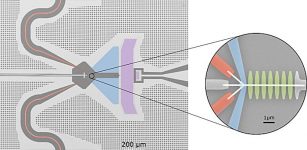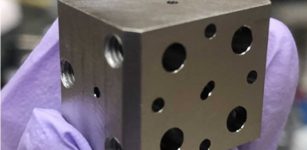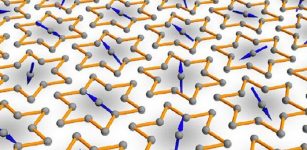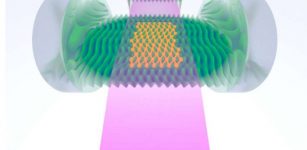Physicists Focus On ‘Magnon’ Discovered Three Years Ago In 2D Magnet
Eddie Gonzales Jr. – MessageToEagle.com – Rice physicists have confirmed the topological origins of magnons, magnetic features they discovered three years ago in a 2D material that could prove useful for encoding information in the spins of electrons.
 Graduate student Lebing Chen displays chromium triiodide crystals he made in a Rice University laboratory. Stacked layers of atomically thin 2D chromium triiodide have unusual electronic and magnetic properties that could prove useful for technologies that encode information in the spins of electrons. Credit: Jeff Fitlow/Rice University
Graduate student Lebing Chen displays chromium triiodide crystals he made in a Rice University laboratory. Stacked layers of atomically thin 2D chromium triiodide have unusual electronic and magnetic properties that could prove useful for technologies that encode information in the spins of electrons. Credit: Jeff Fitlow/Rice University
The discovery, described in a study published online this week in the American Physical Society journal Physical Review X, provides a new understanding of topology-driven spin excitations in materials known as 2D van der Waals magnets. The materials are of growing interest for spintronics, a movement in the solid-state electronics community toward technologies that use electron spins to encode information for computation, storage, and communications.
Spin is an intrinsic feature of quantum objects and the spins of electrons play a key role in bringing about magnetism.
Rice physicist Pengcheng Dai, a co-corresponding author of the study, said inelastic neutron-scattering experiments on the 2D material chromium triiodine confirmed the origin of the topological nature of spin excitations, called magnons, which his group and others discovered in the material in 2018.
The group’s latest experiments at Oak Ridge National Laboratory’s (ORNL) Spallation Neutron Source showed “spin-orbit coupling induces asymmetric interactions between spins” of electrons in chromium triiodine, Dai said. “As a result, the electron spins feel the magnetic field of moving nuclei differently, and this affects their topological excitations.”
In van der Waals materials, atomically thin 2D layers are stacked like pages in a book. The atoms within layers are tightly bonded, but the bonds between layers are weak. The materials are useful for exploring unusual electronic and magnetic behaviors. For example, a single 2D sheet of chromium triiodine has the same sort of magnetic order that makes magnetic decals stick to a metal refrigerator. Stacks of three or more 2D layers also have that magnetic order, which physics call ferromagnetic. But two stacked sheets of chromium triiodine have an opposite order called antiferromagnetic.
That strange behavior led Dai and colleagues to study the material. Rice graduate student Lebing Chen, the lead author of this week’s Physical Review X study and of the 2018 study in the same journal, developed methods for making and aligning sheets of chromium triiodide for experiments at ORNL. By bombarding these samples with neutrons and measuring the resulting spin excitations with neutron time-of-flight spectrometry, Chen, Dai and colleagues can discern unknown features and behaviors of the material.
In their previous study, the researchers showed chromium triiodine makes its own magnetic field thanks to magnons that move so fast they feel as if they are moving without resistance. Dai said the latest study explains why a stack of two 2-D layers of chromium triiodide has antiferromagnetic order.
“We found evidence of a stacking-dependent magnetic order in the material,” Dai said. Discovering the origins and key features of the state is important because it could exist in other 2D van der Waals magnets.
Written by Eddie Gonzales Jr. MessageToEagle.com Staff










